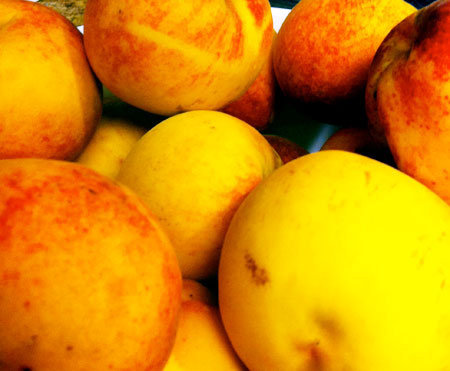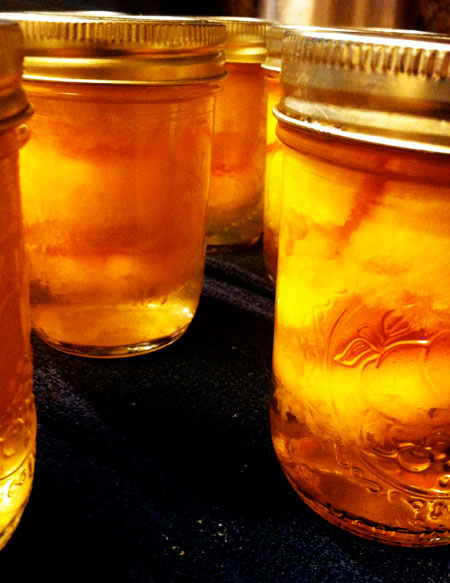Before I moved to Birmingham, I assumed, like most people, that since Georgia was famous for peaches, it must grow the best-tasting peaches in the country. Makes sense, right?
Wrong. Chilton County, about 45 minutes south of here, produces the sweetest, most delicious peaches I’ve ever had. Clanton, the county seat, is home to a giant peach water tower and Peach Park, famous for its (peach) ice cream.
I buy a container of Chilton County’s finest just about every week at the farmer’s market, but in late summer as the season comes to an end, I always buy a huge bucket of peaches and can ’em. Canning is something of a lost art, but most grocery stores sell the supplies you’ll need, and it’s not that hard. Plus you get to feel like a Depression-era housewife!
Canning peaches does take some labor and will occupy your whole stove for an hour or two, so it’s probably best left to a weekend afternoon. But do it once and you’ll have fresh-tasting peaches to use in cobbler all winter long. I like to can peaches in pint jars, because a pint of peaches is just about enough for a half-recipe of Sara Moulton’s Easy Peach Cobbler, something Nadria and I have for dessert once or twice a month.
You need:
1 HUGE stockpot (biggest you have; it needs to be able to submerge the jars completely)
1 large pot
1 medium saucepan
1 small saucepan
Canning jars with lids and bands (pint jars will hold about 2 peaches, quarts will hold 4 to 5; plan accordingly. Also, you can reuse jars and bands but not lids.)
Peaches (try to find freestone as opposed to cling; the pits are much easier to remove)
Sugar
Half a lemon
There are six steps to canning, the first four of which you can do simultaneously:
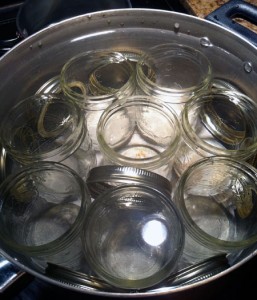 1. Sterilize jars. Place the jars into your stockpot and fill with enough water to completely cover the jars. Cover and place over high heat. Boil the jars while you do the rest of the steps. (If your pot can’t fit all your jars, boil a batch for 10 minutes, remove and place on a clean towel, and then boil another batch.)
1. Sterilize jars. Place the jars into your stockpot and fill with enough water to completely cover the jars. Cover and place over high heat. Boil the jars while you do the rest of the steps. (If your pot can’t fit all your jars, boil a batch for 10 minutes, remove and place on a clean towel, and then boil another batch.)
2. Prepare lids. Place the lids in the small saucepan, cover with 1 to 2 inches of water, and heat to a simmer over medium heat. Reduce heat to low and keep hot until ready to use. (This sterilizes the lids and softens the sealing material so you get a good airtight seal.)
3. Make syrup. Combine 6 cups of water and 2 cups of sugar in the medium saucepan and bring to a boil over high heat. Reduce heat to low and keep hot until ready to use. (This is enough for 8 to 10 quart jars, and is a relatively light syrup, which works well for super-sweet Chilton County peaches. Use a 2:1 or 1.5:1 ratio of water to sugar for a heavier syrup.)
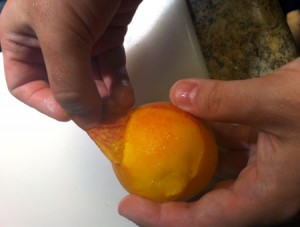 4. Prepare peaches. Fill the large pot 1/2 to 3/4 full of water and bring to a boil over high heat. Fill a large bowl halfway with ice and add a few cups of cold water. Cut an “X” shape in the bottom of each peach, and drop into the boiling water for 1 to 2 minutes. Remove to the ice bath until cool. Squeeze half a lemon into another large bowl and add a few cups of water. Peel peaches. If skin does not come off easily, boil for another minute and chill in the ice bath again. (This method is also great to peel tomatoes.) Cut in half and remove pits, then slice as desired (you can just can the halves as-is, or slice into smaller pieces) and place into the lemon water to keep from browning.
4. Prepare peaches. Fill the large pot 1/2 to 3/4 full of water and bring to a boil over high heat. Fill a large bowl halfway with ice and add a few cups of cold water. Cut an “X” shape in the bottom of each peach, and drop into the boiling water for 1 to 2 minutes. Remove to the ice bath until cool. Squeeze half a lemon into another large bowl and add a few cups of water. Peel peaches. If skin does not come off easily, boil for another minute and chill in the ice bath again. (This method is also great to peel tomatoes.) Cut in half and remove pits, then slice as desired (you can just can the halves as-is, or slice into smaller pieces) and place into the lemon water to keep from browning.
5. Fill jars. Fill jars with peaches, leaving at least 1/2 inch of space at the top. Pour in syrup, filling jars completely but leaving 1/4 to 1/2 inch of space at the top. Run a butter knife along inside of jars to release any air bubbles and ensure jar is filled completely. Place lids on top of jars and screw bands on just until tight.
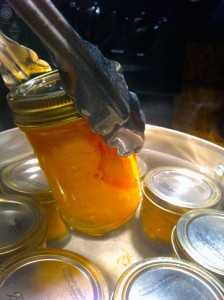 6. Process jars. Place the sealed jars in the stockpot and fill with water to cover (it’s a good idea to reuse the same water you sterilized the jars with so you don’t have to heat it all the way back up, but you’ll need to dump some out so you don’t overflow the pot). Cover, bring to a boil over high heat, and boil 25 minutes. Remove (I just use tongs, but a jar lifter [aff. link] might be easier) the jars to a towel and let cool completely.
6. Process jars. Place the sealed jars in the stockpot and fill with water to cover (it’s a good idea to reuse the same water you sterilized the jars with so you don’t have to heat it all the way back up, but you’ll need to dump some out so you don’t overflow the pot). Cover, bring to a boil over high heat, and boil 25 minutes. Remove (I just use tongs, but a jar lifter [aff. link] might be easier) the jars to a towel and let cool completely.
Once the jars are cool, you can remove the bands and stick in your pantry for a year or more. It’s probably a good idea to check the seals by trying to lift the jar by the lid—if the lid comes off, stick the jar in the fridge and eat within a few days.
